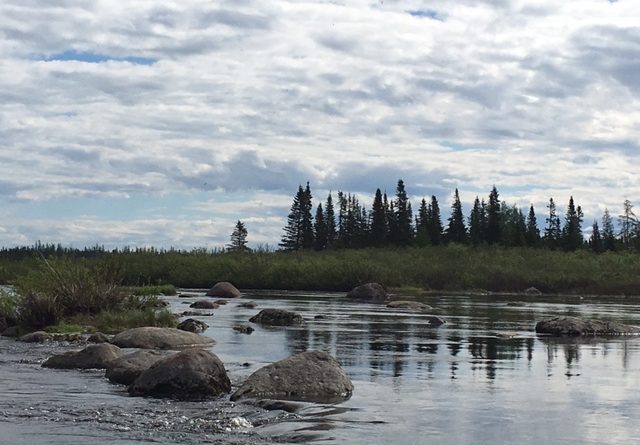A Crooks Lake Story
A Crooks Lake Story
By Chris Sinclair

As the sun shines through my fly repellant caked windows, I am greeted with the lakes reflection of black spruce which dot the thick moss of the boreal forest in Southern Labrador. The day starts with making a fire in the main lodge, then the guide shack; followed by a hot cup of black tea. The suns heat warms the dew from the walkway and Labrador Tea surrounding it. A thick layer of fog lies low across the lake; like a blanket for the cool night’s air against the sun’s high UV rays. The sky is expansive, bordered by the matchstick spruce and fir near, and far the mountains jut out of the horizon in rounded rolling swellings of solid rock. Breakfast starts to sizzle on the frying pan, usually a combination of eggs, processed meat and twice cooked bread. Clients emerge from their rooms with stomachs empty and minds full of expectations of slow rises by dark backed trout that frequent the deep runs draining Crooks Lake on the Upper Eagle River.
After breakfast, the smell of gasoline then enters my nose, filling of the fuel tanks for a long day on the water. The bailing of the aluminum boats lining the shore, which were sprinkled with the light rain of last evening is up next. As the last scoop of water empties the stern of the boat, the sports emerge from the lodge donned from head to toe in name brand fly fishing apparel. Each carrying multiple rods in hand, and their dozens of fly boxes tucked into every nook and cranny in their jackets, packs and bags.
With a couple hauls the motor stars and I pull the boat up to the wharf and the sports hop in. The fifteen horsepower hums down the lake to the outlet of the 10+ km in length basin named Crooks Lake. The shoreline is dotted with sand beaches, rocky outcrops and twisted driftwood from years past. Large boulders lie just beneath the dark waters surface ready to strike if not paid attention to. As the outlet nears, rocks become more frequent and navigating the channel can be tricky. The boat glides down through the deep water and constant throttle on an outstretched hand is needed to stay in the rocky slanting channel. I drop anchor in the shallows of the river to sit and wait for a fish to rise. The rushing of the river and calls of the birds set the tone for a great day on the water.

The mayflies are coming off the bushes in a large spinner fall; clear wings, dark bodies and three tails land on the surface after completing their life cycle… A trout picks out the spinners from the bright background of the sun, continuing to feed in slow sips on the edge of the current about 30 ft from us. We have found our target fish; I suggest a #14 dark dun parachute mayfly pattern to my client, a fly thats worked for me many times over.
The trout continues to rise, and with a tight knot and a strong leader the fly is cast a few feet upstream of its lie with a soft fall to the water. The fly rides in the film of the slow current with a drag-free drift; a perfect cast I think aloud. With a familiar slow sip the fish rises to our presentation showing us its head, back and tail.
A heavy fish comes tight on the hook-set and runs down river, ripping line from the deck of the boat and onto the reel. The classic sound of a Hardy reel sings across the open floodplain, a sound that is familiar to the trees and animals of the wilderness here. The client turns to me with wide eyes and a toothed smile as he plays the fish in the current.

The fish dogs down with big head-shakes in the deep water of the run. A strong arm with a quick change of rod position and the fish moves out of its holding spot. A few turns on the reel and the fish comes upstream quickly, turns of the handle keep the line tight- stopping the fish from shaking the hook free. A few minutes pass and eventually the fish comes to the surface, head shaking and showing its sides; almost ready to admit defeat.
More line enters the reel, the rod bending almost double. I grab the net as the fish nears the gunnel of the boat, the client brings the fish back to the surface and turns its head downstream to the gaping net. I lift the net to the waters surface and the fish is in the basket. Kept underwater the fish flops around and settles facing upstream into the current. Water filled with dissolved oxygen flows through its gills, reviving the fish after a furious bout.

A fish of a lifetime is in the net, I reach down and pull the barbless hook from the jaws of a monster. I pass the net to the eager sport as he wets his hands and lifts the fish up for a quick photo. A photo taken with water dripping off the smily skin ensures the fish doesn’t dry out and maintains healthy. The trout is placed back into the net to be weighed. I attach a scale to the rubber mesh and lift reading the scale at 9 3/4 pounds, sans 2 1/2 for the net. A brook trout weighing 7 1/4 pounds is absolutely incredible, on a dry fly it is something from a dream. Placing the fish back in the water for release it swims off in within a few kicks. The excitement on my client’s face, followed by a great handshake ends off an amazing catch. As he sits there to take in the whole experience, I scan the water for another player and enjoy the warm sun and cool breeze of a big land summer.




